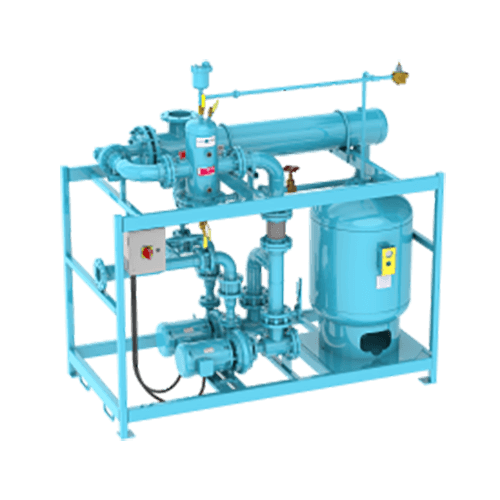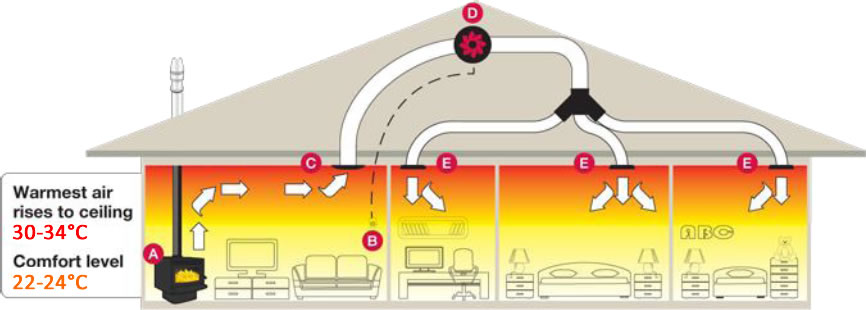DVS Heat Transfer Systems: A Complete Guide to Smarter IoT Integration
Wiki Article
A Comprehensive Guide to Picking the Right Heat Transfer Solutions for Your Needs
Selecting the appropriate Heat transfer system is crucial for functional performance. Numerous systems cater to different requirements, affected by aspects such as temperature variety and liquid type. Comprehending the principles behind Heat transfer, such as convection, transmission, and radiation, is vital. In addition, reviewing energy resources and maintenance methods can impact lasting performance. A closer examination of these considerations discloses exactly how to customize a system to particular requirements. What should one prioritize in this facility decision-making process?Comprehending Heat Transfer: Secret Principles and Principles
Heat transfer may seem like a straightforward idea, it includes a variety of principles that are basic for effective system layout - DVS Heat Transfer Systems. Comprehending these concepts is vital for developers and designers that intend to maximize thermal efficiency in numerous applications. Transmission, as an example, involves the transfer of Heat through strong materials, while convection refers to the movement of Heat within fluids. Radiation, one more crucial concept, defines just how Heat can be transferred through electro-magnetic waves. Each of these devices plays a crucial duty in identifying exactly how energy moves within a system. By completely comprehending these ideas, specialists can make enlightened choices, ensuring that Heat transfer systems operate successfully and satisfy the specific demands of their applications
Kinds Of Heat Transfer Systems: An Overview
Understanding the principles of Heat transfer prepares for discovering the different types of Heat transfer systems available. Heat transfer systems can be classified mostly into 3 kinds: transmission, radiation, and convection. Conduction includes Heat transfer with solid materials, relying upon straight get in touch with between fragments. Convection, on the other hand, occurs in liquids (fluids and gases) where the activity of the liquid itself helps with Heat transfer. Radiation involves the transfer of Heat through electro-magnetic waves and does not need a medium, permitting it to happen in a vacuum. Each kind of system has unique characteristics and applications, making it essential for individuals and companies to very carefully evaluate their particular needs when picking the most appropriate Heat transfer solution.Applications of Heat Transfer Systems in Various Industries
Heat transfer systems play an essential function across numerous industries, impacting efficiency and product high quality. In commercial manufacturing processes, they promote exact temperature level control, while in food and beverage processing, they assure safety and preservation. In addition, a/c and environment control systems depend greatly on efficient Heat transfer to preserve comfy environments.Industrial Production Processes

Numerous industrial production processes depend greatly on reliable Heat transfer systems to take full advantage of performance and boost item quality. In industries such as metalworking, Heat exchangers play a crucial role in maintaining excellent temperature levels throughout welding, casting, and forging. These systems assure consistent Heat circulation, which is vital for achieving wanted product residential or commercial properties. In the chemical production industry, Heat transfer systems assist in specific temperature level control throughout reactions, influencing yield and safety. Additionally, in fabric manufacturing, efficient Heat management is essential for dyeing and finishing processes, affecting shade uniformity and textile high quality. By choosing appropriate Heat transfer innovations, producers can boost power effectiveness and decrease functional costs, inevitably bring about a much more affordable and sustainable production setting.
Food and Drink Processing
Reliable Heat transfer systems are similarly crucial in the food and beverage handling sector, where preserving perfect temperatures is essential for food safety and top quality. These systems play a necessary function in processes such as sanitation, food preparation, and pasteurization, making certain that products are secure for intake and preserve their dietary worth. Heat exchangers, as an example, efficiently move Heat in between liquids, enhancing energy use while minimizing temperature variations. Additionally, refrigeration systems are fundamental for expanding and preserving disposable things rack life. The choice of Heat transfer technology directly influences functional efficiency and product honesty, making it crucial for food and drink producers to pick the appropriate systems tailored to their specific processing demands. This mindful selection ultimately adds to consumer satisfaction and food safety.
Heating And Cooling and Climate Control
While several industries rely upon Heat transfer systems for effectiveness, A/C (Heating, Air Flow, and Cooling) plays an essential duty in preserving interior environment control across different settings. These systems use Heat transfer principles to control air, temperature, and moisture quality, making certain comfort and safety in household, commercial, and industrial settings. Effectively designed heating and cooling systems improve power efficiency, decrease operational expenses, and reduce ecological influence. In commercial buildings, as an example, reliable climate control adds to staff member productivity and customer satisfaction. In commercial applications, cooling and heating systems help maintain perfect conditions for equipment operation and item conservation. Choosing the ideal Heat transfer system is important for conference details environment control demands and accomplishing general system efficiency.Examining Power Sources for Heat Transfer Systems
In evaluating power resources for Heat transfer systems, a comparison of renewable resource choices and fossil gas factors to consider is necessary. Renewable sources, such as solar and wind, offer sustainable choices that can lower environmental influence. Alternatively, fossil fuels stay widespread because of their established facilities and energy density, triggering a careful evaluation of both alternatives.Renewable Resource Options

Fossil Fuel Considerations
Reviewing fossil fuel factors to consider is essential for the effectiveness and sustainability of Heat transfer systems. Fossil fuels, such as gas, oil, and coal, are standard power resources that offer significant Heat outcome, making them preferred choices for industrial and household applications. Nevertheless, their environmental influence, including greenhouse gas exhausts and source exhaustion, elevates worries. When picking a warm transfer system, it is essential to assess the schedule, cost, and regulative variables associated with these fuels. Furthermore, the performance of nonrenewable fuel source systems have to be thought about, as higher effectiveness can alleviate some ecological drawbacks. Ultimately, a well balanced method considering performance and sustainability can lead decision-makers toward the most ideal Heat transfer remedy for their particular demands.Elements to Consider When Selecting a Heat Transfer System
Selecting a suitable Heat transfer system requires cautious factor to consider of numerous aspects that can significantly affect performance and efficiency. One essential factor is the operating temperature range, which determines the products and layout appropriate for the application. Additionally, the kind of fluid made use of in the system-- whether gas or fluid-- impacts Heat transfer effectiveness and compatibility. The system's dimension and ability must align with the specific demands of the procedure to avoid inefficiencies. Power resource accessibility is likewise necessary, affecting operating expense and sustainability. The installment atmosphere, including room constraints and access for upkeep, plays a substantial duty in system option. Regulatory compliance and safety standards must be considered to assure the system fulfills all legal needs.Maintenance and Performance Optimization for Heat Transfer Systems
Preserving Heat transfer systems is essential for making certain optimal efficiency and durability. Regular maintenance activities, such as cleaning Heat exchangers and examining insulation, aid stop efficiency losses because of fouling and thermal bridging. Furthermore, keeping track of system criteria, including pressure and temperature level, permits very early detection of abnormalities, minimizing downtime and expensive repair work. Applying a precautionary upkeep schedule can enhance efficiency and prolong the life expectancy of parts. Upgrading to innovative control systems can improve functional performance by readjusting to varying problems and loads. By prioritizing upkeep and efficiency optimization, drivers can accomplish reduced energy intake, lower operational costs, and boosted overall system dependability, ultimately resulting in better resource usage and a much more sustainable operation.Future Patterns in Heat Transfer Technologies
As sectors increasingly focus on sustainability and power performance, future fads in Heat transfer modern technologies are readied to go through substantial makeovers. Innovations such as sophisticated products, including carbon nanotubes and nanofluids, guarantee enhanced thermal conductivity and efficiency. Furthermore, the assimilation of renewable resource sources into Heat transfer systems is gaining energy, advertising environment-friendly solutions. Smart technologies, consisting of IoT sensing units, are expected to change surveillance and control, enabling real-time information analysis for optimized efficiency. The growth of small and modular systems will assist in simpler installment and maintenance, providing to varied applications. These advancements show a change in the direction of even more lasting, effective, and adaptable Heat transfer remedies, straightening with worldwide power goals and environmental criteria.
Regularly Asked Questions
What Are the Environmental Influences of Heat Transfer Systems?
The environmental influences of Heat transfer systems can include greenhouse gas emissions, power consumption, and potential thermal pollution. In addition, improper disposal of materials and inadequacies can contribute to source deficiency and ecosystem disturbance.How Do I Determine the Cost-Effectiveness of a Warmth Transfer System?
To determine the cost-effectiveness of a warmth transfer system, one must examine preliminary prices, functional expenditures, maintenance demands, and power efficiency, contrasting these elements versus the expected lifespan and performance of the system.Can Heat Transfer Equipment Be Used in Residential Settings?
Heat transfer systems can without a doubt be made use of in domestic settings. They provide effective heating and cooling down solutions, making homes much more comfortable while possibly lowering energy prices. Their adaptability enables different applications in household environments.What Security Regulations Put On Heat Transfer Systems?
Security laws for Heat transfer systems generally consist of standards on upkeep, installment, and operation. Compliance with local building regulations, producer specifications, and sector requirements is necessary to assure efficient and secure system efficiency in numerous applications.How Do Different Materials Affect Heat Transfer Efficiency?

Conduction, for instance, includes the transfer of Heat through strong materials, while convection refers to the movement of Heat within liquids. Recognizing the principles of Heat transfer lays the groundwork for discovering the various types of Heat transfer systems available. Heat exchangers, for circumstances, effectively move Heat between fluids, maximizing power usage while lessening temperature level variations. In examining power sources webpage for Heat transfer systems, a contrast of eco-friendly power choices and fossil fuel considerations is crucial. Steels, such as copper and light weight aluminum, conduct Heat effectively, whereas insulators like rubber and glass reduce down Heat flow.
Report this wiki page